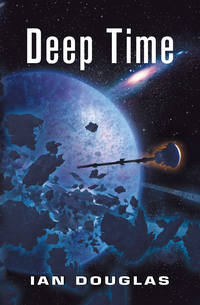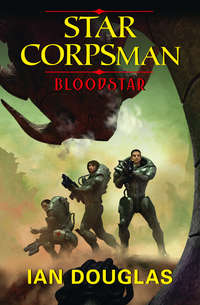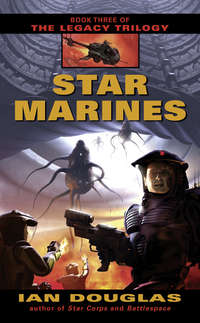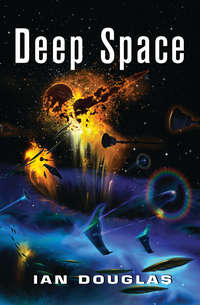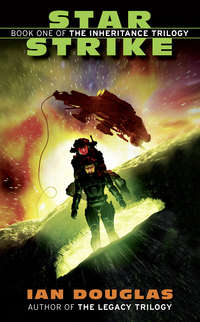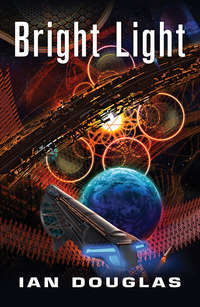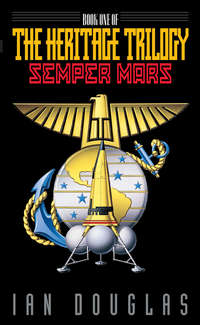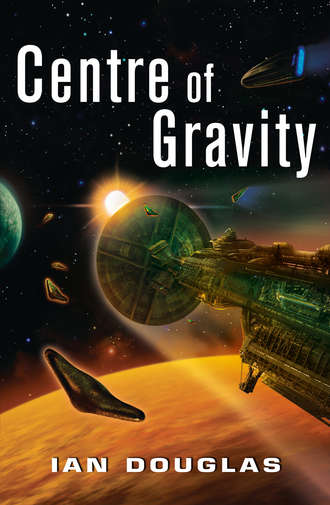
Полная версия
Centre of Gravity
“Dragon Three, ready for boost,” Donovan’s voice reported.
“Seven, flight ready,” Lieutenant Walsh said.
The others began chiming in, one after another. “Dragon Nine, ready to lift,” Gray said, as around him the other fighters drifted up from the ground, levitating a few meters into the night sky. Only two, Dragonfires Five and Eleven, remained lifeless on the tarmac.
Perhaps, Gray thought, he should say something to the skipper. But one societal quirk of the Navy was identical to one found in the squatters living in the Manhat Ruins. You didn’t carry tales about others, even if you hated them. Being marked as an informer, a tattler, could be as socially crippling as being a Prim.
So long as withholding the information didn’t compromise the squadron or a mission, he would keep what he knew about Kirkpatrick to himself.
“Situational update is coming on-line,” Allyn told them.
Gray saw the data coming through … a ship of alien design, almost certainly one belonging to a Sh’daar subject race, was approaching cis-lunar space. He looked at the stats and gave a low whistle. The thing was huge.
“VFA–44,” a voice came in over the com link, “this is New York Met ATC. You are cleared for emergency launch, vector one-zero-eight plus four-one degrees at ten gravities, over.”
“New York Met ATC,” Allyn replied. “We copy clear for emergency launch, vector one-zero-eight plus four-one degrees at ten gravities. Thank you.”
“Roger and Godspeed, VFA–44.”
“Stand by to boost, close formation,” Allyn said. “Nav on auto.”
Together, the ten fighters swung their needle prows up to a forty-one-degree angle off the tarmac, then swung to face the southern horizon. Gray could see the string of faint stars marking the SupraQuito strand up in synchorbit almost directly ahead.
“Ten gravities, in four,” Allyn continued, “… three … two … one … boost!”
As one, the ten fighters hurtled skyward at one thousand meters per second per second. Gray had a brief, blurred impression of the massed lights of the eudaimonium falling away below and behind as the fighters shrieked through fast-thinning atmosphere. He thought of Angela … and decided it was good knowing she was alive.
He wondered if he would ever see her again … wondered if he wanted to.
The Starhawks had been in their atmospheric configuration for their flight in over the ocean earlier that evening, their manta-wings stretched wide to assist with banks, turns, and lift. There was no need for such finesse on the way up, however. To reach space they required only raw, savage power and high Gs. The needle configuration gave the greatest streamlining and, as the fighters climbed above the forty-thousand-meter line, they were able to feed more and more power to the flickering singularities off their bows, increasing their accelerations to just over five hundred Gs, increasing their velocities by half a million meters per second per second.
As they rose above the tenuous, uppermost wisps of Earth’s atmosphere and the stars became colder, harder, and more brilliant, flight control transferred from New York Metropolitan to SupraQuito. At the halfway point, eighteen thousand kilometers out and just two minutes later, they switched their singularities around to aft and began slowing.
“So why are we going back to the barn, Skipper?” Lieutenant Terrance Jacosta asked. “This download says the enemy is just half a million kilometers out!”
“Because we’re flying just a little light on snakes right now, numb-nuts,” Allyn replied. “Get your head out of party mode and get with the program!”
“Oh, yeah. Right.”
They’d not needed missile or impactor round load-outs for a fly-by above a friendly city, so the only weapons capability the squadron had at the moment were their StellarDyne Blue Lightning PBP–2 particle beam projectors, since those weapons pulled charged particles directly from the zero-point field. The weapons of choice for long-range work, however, were VG–10 Krait smart missiles. Starhawks generally carried a warload of thirty-two Kraits, or snakes, plus fifty thousand rounds apiece for their kinetic-kill Gatling cannons.
Gray looked at the schematic of the intruder. Sending a squadron up against that thing with nothing but beam weapons would be suicide the easy way. At least with Kraits, usually carried in load-outs with variable-yield warheads of five to fifteen kilotons, you could stand off at long range and pound the bastard until something gave. With the PBP, you had to be close, and you had to be surgically precise. With something that big, you might get better results giving the alien the finger.
In close formation, then, the ten fighters neared the SupraQuito dock facility. Gray could see America in her berth, connected to the main base structure by a transit tube and a web-work of mooring lines. Still slowing, now, to a few tens of meters per second, they passed the carrier and the dock beneath their keels—though concepts such as up and down, of course, had no meaning in microgravity. Clearing the structure by seven hundred meters, they continued decelerating, balancing their drive singularities to bring them to a dead halt relative to the America, just half a kilometer off her stern.
“VFA–44,” a voice said, “you are cleared for trap in Landing Bay Two.”
“Dragon One,” Allyn’s voice replied. “Copy. Okay, people. Switch to AI approach. Land by reverse numbers.”
Cutting their drives and flipping end-for-end, they opened aft venturis and fired their plasma-maneuvering thrusters, using jets of super-heated water as reaction mass. Unlike uniform gravitational acceleration, the thrusters had a kick. Gray was plastered against the embrace of his seat at three Gs as he began gaining speed once more, this time directly toward the aft end of the America.
In normal space operations, they would be using their gravitic drives and coming in from much farther out, at much higher speeds. Trapping on board a carrier snugged up to the dock was child’s play by comparison, or it would have been if a missed cue or a lapse in concentration hadn’t risked punching through the gossamer strands and struts of the synchorbital base.
The hab modules on board the carrier were turning, providing spin gravity for the crew. Each approach had to be precisely on the money; Dragonfire Twelve—Lieutenant Jacosta—made the first approach, accelerating slightly as he slid into the deep shadow beneath the carrier’s belly, then at the last moment fired his lateral thrusters to give him a side vector of seven meters per second, matching the movement of the landing bay as it swung in ahead and from the right. Dragonfire Eleven—Kirkpatrick—was missing from the formation. Tucker was next, in Dragon Ten.
The landing bay was rotating at 2.11 turns per minute, so every twenty-eight seconds, the opening swung around once more and another incoming fighter was there to meet it.
And now it was Gray’s turn. Traveling at one hundred meters per second, he passed into the shadow beneath the carrier, watching the massive blisters, domes, and sponsons housing the ship’s quantum taps and drive projectors smoothly passing seemingly just above his head. It took almost ten seconds for him to traverse the length of America’s spine. His AI used his thrusters to adjust his speed with superhuman precision, dropping into the sweet-spot moving pocket and nudging him to port for that critical side-vector of seven meters per second. For an instant, the gaping maw of the moving docking bay appeared to freeze motionless as the fighter swept in across the line of deck acquisition lights. At the last moment, he entered the tangleweb field that slowed his forward momentum sharply, bringing him to a halt.
Magnetic grapples clamped hold of his ship and rapidly moved it forward, clearing the docking bay for the next incoming fighter, just under thirty seconds behind him. As the fighter dropped through a liquid-nano seal and into the pressurized bay immediately beneath the flight deck, he thought-opened the Starhawk’s side and pulled off his helmet with a heartfelt sigh of relief.
He was home, and where he belonged … even if for only a few minutes.
Chapter Five
21 December 2404
High-G Orbital Shuttle Burt Rutan
Approaching SupraQuito Fleet Base
Earth Synchorbit, Sol System
1532 hours, TFT
Captain Randolph Buchanan and several of his aides had gone down the Quito space elevator that afternoon to reach the eudaimonium. Normally, he would have taken the captain’s gig down to Giuliani, but an engineering downgrudge report had taken his gig off of flight-ready status, and he’d relied on civilian transport instead.
That had left him at something of a disadvantage when the fleet recall had come through. He could have gone back to the ship with Admiral Koenig, but there’d not been time to find him or the admiral’s barge in the chaos down there.
Instead, the Burt Rutan had been summarily commandeered by no less a luminary than Admiral of the Fleet John C. Carruthers, and Buchanan and several other high-ranking officers and aides had climbed aboard a mobile passenger module at the eudaimonium docking area for the short flight north to the spaceport.
The Rutan was a cargo transport, designed to boost heavy loads up to synchorbit for the ongoing construction of the bases and facilities tethered high above Quito, and she was not designed with passenger comfort in mind. The passenger module slipped into the big shuttle’s cargo deck and locked home. It was claustrophobic on board, with few amenities, but with a boost of five hundred gravities, it would take less time to reach synchorbit than it had for the flight from the eudaimonium to Giuliani.
Buchanan leaned back in the embrace of the hab seat as the vast, light-dusted blackness of Earth’s night side, aglow with cities, dropped away aft. He was linked through his implant to Commander Sam Jones, America’s executive officer. Admiral Koenig was riding the link from the Admiral’s barge, which was trailing by a hundred kilometers, following the Rutan in to the docking facility. Koenig was listening in, but not interfering. Captain Barry Wizewski, America’s brand-new CAG, was also on board the civilian shuttle, linked in with the communications net connecting the Rutan with the carrier’s CIC.
“Damn it, Sam, I want full readiness for space five minutes after I step onto the quarterdeck,” Buchanan growled.
“We’re working on it, sir,” Jones replied, “but things are kind of chaotic on board right now. We have civilians on board …”
He spoke the word with evident distaste. In fact, there would be several hundred civilian contractors on the ship, part of the small army of inspection teams and drive magicians who came aboard each time the carrier entered its berth.
“They can come along with us, Number One. We won’t be going far.”
“We also have about a thousand ship’s personnel coming in from liberty. A lot of them won’t make it for an hour or two.”
“Then we’ll boost without them,” Buchanan said. He glanced at the comm icon representing Koenig. “What’s the status on the fighter wings?”
“VFA–44 is coming on board now, sir. We’re ten for twelve there. VFA–31 is on deep patrol but has been recalled. They should get the recall order in another two hours. VFA–49 is on Ready Five. The others are scrambling. We went to GQ about seven minutes ago.”
America carried six fighter and fighter-attack squadrons in all.
“Whiz?” Buchanan said, addressing America’s CAG. “I’d like to get the Peaks out there, too. What do you think?”
“I’m giving the orders now, Captain.”
VQ–7, the Sneaky Peaks, was America’s reconnaissance squadron, flying under the flamboyant Commander James Henry Peak. Flying CP–240 Shadowstars, they would have the best chance of getting close to the intruder spacecraft without being noticed.
“How long before the Dragonfires are rearmed and set for launch?”
“Twenty minutes, sir.”
Buchanan nodded. Twenty minutes was damned fast. The ready crews would be busting ass to turn those fighters around.
“Do you have anything to add, Admiral?” he asked.
“I suggest that we get all squadrons spaceborne ASAP, and keep them out there,” Koenig said from his barge. “Priority to the fighters, of course, but get the EW and SAR squadrons off the carrier as quickly as you can. America will be a target, especially while she’s in dock.”
“Aye, aye, sir.” That made sense. If America was crippled or destroyed while still in dock, at least her fighters would be spaceborne and on an attack vector.
“Number One,” Buchanan continued, “get my ship out of dock if you have to cut the lines with a pocket knife and haul her out on your shoulder.” He glanced at the Rutan’s bulkhead display. The shuttle was approaching the carrier now, approaching over the curve of her shield cap. He could see a fighter coming in from astern, heading for a trap on the hangar deck. The Rutan wouldn’t be going in that way. They would dock in zero-G, the quarterdeck docking bay, just forward of the rotating hab modules. “We’re about five minutes from docking, so stop gabbing with me and get on it!”
“Aye, aye, Captain.”
When it came to wielding a star carrier, three men, in a sense, shared the command responsibilities. Buchanan himself commanded the America. Captain Wizewski, as CAG, was responsible for the 102 spacecraft of CVW–14, the Carrier Air Wing, currently deployed aboard. And Admiral Koenig was in overall command of America’s Carrier Battlegroup, CBG–18, which included not only the carrier herself, but the nine other ships currently attached to the CBG. His orders, and his strategic and tactical thinking, had to take in all ten vessels and the deployment of America’s fighters.
He was grateful that Koenig hadn’t interfered as he’d given orders to Jones. Too many group COs did that … and it undercut a captain’s authority on his own bridge. Koenig, he knew, was probably champing at the bit to get the America under way more than was Buchanan, but he’d spoken only when directly asked if he had any recommendations.
The admiral was one of the good ones, the sort of CO for whom the entire CBG would go to hell and back. He checked the update on the intruder. It was accelerating now … possibly maneuvering to head out-system, though it was too soon to tell. Taking on that puppy would be akin to a stroll in hell, yeah.
Impatiently, Buchanan remained still and silent as the Rutan maneuvered toward the quarterdeck docking bay. The bulkheads of the Rutan’s passenger hab were projecting an all-around view of the exterior now, creating the illusion that they had gone translucent. Directly to port, the underside of the carrier’s shield cap rose like an immense, gray-black cliff; to starboard, the vessel’s hab modules continued their steady and stately rotation, making one complete swing around America’s central spine 2.11 times each minute, or once in twenty-eight seconds.
Ahead, a rectangular hatchway had opened in the side of the carrier’s spine, illuminated by bright white lights set into the deck. From this angle, the quarterdeck accessway connecting the ship with the base docking facility seemed to drop in from directly overhead and slightly aft of the open bay.
And then the Rutan, on AI pilot, glided silently through the opening and into the Star Carrier America.
H’rulka Warship 434
Cis-Lunar Space, Sol System
1534 hours, TFT
“We are not going to strike the vermin?” Swift Pouncer asked over the ship’s internal communications network. Speaking only in radio, without the added color and modifying overtones of its sonic speech, the words were empty of all emotion.
But Ordered Ascent knew what the others must be feeling.
“We have the technological advantage,” Ordered Ascent replied, knowing that all of the other All of Us were listening closely. “But that advantage is not great enough to allow us to fight an entire star system. Too many of us would fall into the Abyss. It is far more important that the Masters know of these aliens, and that they have been sending probes through System 783,451, than it is for us to destroy their ships. The destruction will happen later, be sure of that.”
“A number of vermin ships are closing with us,” High Drifting reported. “We estimate that they will launch weapons within fifteen vu.”
“The vermin defend their nest,” Swift Pouncer added.
Ordered Ascent watched the unfolding tactical situation through its electronic feed from Warship 434’s tactical mind. No fewer than fourteen enemy ships were currently with range of 434’s weapons. It was tempting to destroy those fourteen before dropping into the emptiness between the stars.
The All of Us had served the Masters for some twelves of thousands of gnyii now, ever since the Starborn had first shown the H’rulka how to extract metals from the winds of their world, how to bend gravity to their will, and how, at last, to build ships that would take them to the treasure troves of metals and other elements in orbit beyond the homeworld’s atmosphere. The H’rulka had gone from being essentially atechnic to a star-faring species themselves within the space of twelve-cubed gnyii, the twitch of a minor tentacle, so far as the Masters were concerned.
Ordered Ascent wondered, and not for the first time, why the Masters insisted on suppressing technological advancement throughout the entourage of species they’d brought into the embrace of their feeder nets. The H’rulka had come so far; their combat advantage over these vermin would have been that of the windstorm to the foodfloater, had they been permitted to keep developing their technology.
No matter. The advantage was sufficient.
Ordered Ascent checked other data feeds. Ship 434 was ready to diverge, if necessary, and would be ready to enter metaspace within mere vu.
Any damage done to the enemy was to the good. So long as combat didn’t weaken Warship 434 or threaten her mission, there was no reason not to swat the vermin before they were even close enough to engage.
“Swift Pouncer,” Ordered Ascent said, “destroy those that we can reach.”
“With the pleasure of gentle winds, Ordered Ascent.”
And Warship 434 reached out into the darkness. …
TC/USNA DD Symmons
Cis-Lunar Space, Sol System
1536 hours, TFT
Captain Harry Vanderkamp, commanding the Symmons, watched the tactical display unfolding around him as the ship plunged toward the interloper. The alien ship was accelerating fast, pulling at least seven hundred gravities, and would slip beyond range soon.
Symmons was a member of CBG–18, a fleet destroyer 576 meters long, massing just under thirty thousand tons, and armed with a variety of weapons, including thirty-six launch tubes for VG–24 Mamba smart missiles, variable-yield ship killers ranging between twenty and forty-five kilotons apiece. The H’rulka vessel was 327,000 kilometers ahead now, out of range for most guided weapons, but still within reach of the Mambas.
The problem, though, was that Symmons did not yet have clearance to fire. The ship ahead had clearly been identified as H’rulka, an enemy combatant … but it had been twelve years since the single known encounter between them and Confederation vessels, and Vanderkamp knew he would need clearance from Fleet HQ. There might be diplomatic issues of which he was unaware, or an attempt under way to communicate with the alien.
Symmons had burned repeated laser and radio messages to Fleet Base, only a few light seconds away, but so far with no response.
His gut instinct was to fire. That H’rulka monster might be a recon probe in advance of a larger force.
The enemy ship was accelerating harder now. In seconds, it would be out of range completely. Hell, it might already be too late. …
“Sir!” Vanderkamp’s tactical officer cried over the bridge link. “Kaufman has been hit!”
“Show me!”
The tactical display switched to a view from one of the other destroyer’s external cameras, looking forward up the spine toward the underside of the ship’s massive shield cap. The shield, backlit by a hard blue glare, was deforming, crumpling with shocking suddenness, as though it were collapsing into …
“Milton is hit!” A second battlegroup destroyer was folding around her own shield cap. “Target is now breaking up.”
“Breaking up? Breaking up how?”
“It’s just … just dividing sir. Twelve sections, moving apart from—”
“Incoming mass!” his exec shouted. “Singularity effect! Impact in seven … in six …”
Vanderkamp saw it, a pinpoint source of X-rays and hard gamma on the forward scanner display, a tiny, brilliant star sweeping directly toward Symmons’ prow.
There was no time for thought or measured decision, no time for anything but immediate reaction.
“VG–24 weapon system, all tubes, fire!” he yelled, overriding the exec’s countdown. They were under attack, and that decisively ended any need for weapons-free orders from base. “Maneuvering, hard right! Shields up full! Brace for—”
And the H’rulka weapon struck the Symmons.
It hit slightly off center on the destroyer’s bullet-shaped forward shield cap, causing the starboard side to pucker and collapse in a fiercely radiating instant. Water stored inside the tank burst through the rupture, freezing instantly in a cloud of frozen mist that burst into space like a miniature galaxy. The port side of the cap twisted around, collapsing into the oncoming gravitic weapon effect. Vanderkamp felt a single hard, brain-numbing jolt … and then the five-hundred meter spine of the ship whipped around the object, orbiting it with savage velocity as the entire 29,000-ton-plus mass of the Symmons tried to cram itself into a fast-moving volume of twisted space half a centimeter across. Pieces of the ship flew off in all directions as the spine continued to snap around the tiny volume of warped space; the strain severed the ship’s spine one hundred meters from her aft venturis, and the broken segment tumbled wildly away into darkness. Abruptly, the remaining hull shattered, the complex plastic-ceralum composite fragmenting into a cloud of sparkling shards, continuing to circle the fierce-glowing core of the weapon until it formed a broad, flattened pinwheel spiraling in toward that tiny but voracious central maw.
The disk of sparkling fragments and ice crystals collapsed inward, dwindling … dwindling … dwindling …
And then the Symmons was gone.
Seven of her Mamba missiles had cleared their launch tubes before the weapon struck.
TC/USNA CVS America
SupraQuito Fleet Base
Earth Synchorbit, Sol System
1540 hours, TFT
Last on, first off was the custom for boarding and debarking by seniority. Buchanan swam out of the Rutan’s cargo deck hab module and into the boarding tube, followed by other, lower-ranking officers. Rather than wait for America’s forward boat-deck docking bay to repressurize, it was simpler to hand-over-hand along the translucent plastic tube and emerge moments later on the carrier’s quarterdeck.
By age-old tradition, a vessel’s quarterdeck was her point of entry, often reserved for officers, guests, and passengers … though on a carrier like America it served as an entryway for the ship’s enlisted personnel as well. The boat deck offered stowage for a number of the ship’s service and utility boats, including the captain’s gig—the sleek, delta-winged AC–23 Sparrow that by rights should have taken him planetside and back. The quarterdeck was directly aft.


